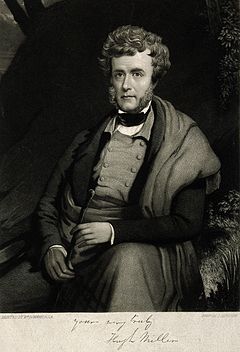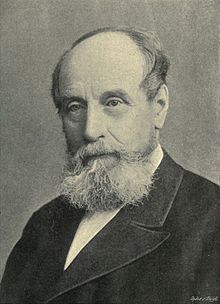コンコーディズムとは:
Concordism: The assumption that the Bible (the word of God) and nature (the works of God) must agree; indeed they tell the same story in different terms. Held by many over the years, but especially important for English and American condordists was the influence of Francis Bacon, in The Advancement of Learning (1605). Bacon influenced the Americans not only in his use of the metaphor of “two books,” but also with his advocacy of natural theology: reading the book of nature with theistic spectacles.
コンコーディズム(調和主義): 神の言葉である聖書と神の作品である自然は一致するはずだという仮定。すなわち、それらは同じ物語を違った言葉で語ったもの。長年にわたって続いてきたが、特に英米のコンコーディストたちにとって重要なのは、Francis BaconがThe Advancement of Learning [ 1605 ]で書いたもの影響である。Baconの米国人への影響は、"二つの書"というメタファーとともに、自然という書を有神論的見方で読むという自然神学の主張である。[ Davis 2002 ]
1830年頃までに、DiluvialismやNeptunismなど聖書創世記のノアの洪水と地質学を整合させようとした試みは消滅した。これに代わって、1810年頃から登場したコンコーディズムである。おおよそ1960年頃まで存在していた[ Jonathan et al. ]。
たとえば、次の人々は創世記の6日間に地球の歴史をひもづけた。
 Hugh Miller (1802 - 1856) スコットランドのアマチュア地質学者・著述業。 |  John William Dawson (1820-1899) カナダの地質学者 |  Arnold Guyot (1807 - 1884) スイス生まれの米国の地理学者・地質学者。 |
表 19世紀の主要なコンコーディストの対応付け[ Young 1987, Table II]
| Miller | Guyot | Dawson | |
| 第1日 | 無生代(*1) 大気が晴れる | 大気が晴れる | |
| 第2日 | シルル紀 大気の成長 | 原始星雲がちぎれて恒星とガス塊なる | 雲と海洋が分離する |
| 第3日 | 石炭紀 青々とした植生の出現 | 地球が冷える 単純な植物のみ | 古生代 大陸の出現 |
| 第4日 | ペルム紀 三畳紀 大気の最終的晴上り | 始生代(*2) 成長する地球から輝きが失われる 太陽が見えるようになる | 太陽の凝集 大陸の再合体 |
| 第5日 | 白亜紀 イクチオサウルス プレシオサウルス 鳥 プテロダクティルス | 古生代と中生代 (Millerのシルル紀から白亜紀に相当) 海洋生物 複雑な植生 | 古生代と中生代 |
| 第6日 | 第3紀(*3) ホニュウ類 | 第3紀(*3) ホニュウ類 | 第3紀(*3) ホニュウ類 |
- Azoic Period(無生代): 現在は廃止
- Archean Period(始生代): Millerの無生代に相当, 現在は38億年前〜25億年前を指す
- Tertiary (第3紀): 現在は廃止され、PaleogeneとNeogeneの2つから構成される(GSJ ニュースレター 2004.10)
また、創世記の記述でキーとされるのは次の部分。
創世記1章2節
And the earth was without form, and void; and darkness was upon the face of the deep. And the Spirit of God moved upon the face of the waters.
地は混沌であって、闇が深淵の面にあり、神の霊が水の面を動いていた。
創世記1章6-8節
And God said, Let there be a firmament in the midst of the waters, and let it divide the waters from the waters.
And God made the firmament, and divided the waters which were under the firmament from the waters which were above the firmament: and it was so.
And God called the firmament Heaven. And the evening and the morning were the second day.
神は言われた。「水の中に大空あれ。水と水を分けよ。」
神は大空を造り、大空の下と大空の上に水を分けさせられた。そのようになった。
神は大空を天と呼ばれた。夕べがあり、朝があった。第二の日である。
創世記7章11節
In the six hundredth year of Noah's life, in the second month, the seventeenth day of the month, the same day were all the fountains of the great deep broken up, and the windows of heaven were opened.
ノアの生涯の第六百年、第二の月の十七日、この日、大いなる深淵の源がことごとく裂け、天の窓が開かれた。
これは多くの人々がさまざまに解釈している。
表 コンコーディストたちの創世記の記述の対応付け[ Young 1987, Table III]
| Gen 1:2 | Gen 1:6-8 | Gen 7:11 | |
| Kirwan | 大海洋が化学物質を降らせる 海洋の加熱により蒸発が厚い闇を作る | 化学降下物の蒸発による大気の形成 | 洞穴と海洋 |
| Buckland | 再創造前の破局後の荒廃した世界 | 砂利の説明のための海洋潮汐 | |
| Fleming | Tranquil洪水 | ||
| Miller | 原始的な海洋 | 大気の成長 シルル紀の堆積とOld Red rocks | 中央アジアの沈降とそれに続く洪水 |
| Guyot | 原始的な状態の物質 ガス状の大気 | 原始星雲がちぎれて恒星とガス塊なる | |
| Dawson | 大気中の水が地球を覆う | 雲と海洋の分離 | カスピ海付近の洪水 |
| Wright | 氷河による地球の沈降 氷河の融解による洪水 | ||
| Newman and Eckerlmann | 星の光を遮るガス雲 | ||
| Stokes | 空間に一様な規則性のない物質と水 | 銀河の渦状腕 ブラックホールによる第2日の闇 |
- Robert C. Newman and Herman Eckelmann: Genesis One and the Origin of the Earth (DownersGrove, IL: InterVarsity Press, 1977).
- William L. Stokes, The Genesis Answer (Englewood Cliffs, NJ: Prentice-Hall, 1984).
- John L. Wiester, The Genesis Connection (Nashville: Thomas Nelson, 1983).
- Dawson, Origin, 256.
- Wright, Scientific Confirmations, 206.
- William Buckland, Reliquiae diluvianae (London: John Murray, 1823 ).
- John Fleming, "The Geological Deluge, as interpreted by Baron Cuvier and Professor Buckland, inconsistent with the testimony of Moses and the Phenomena of Nature," Edinburgh Philosophical Journal 14 (1826) 211.
- George Frederick Wright, Scientific Confirmations of Old Testament History (Oberlin, Ohio: Bibliotheca Sacra, 1906).
- Richard Kirwan, "On the Primitive State of the Globe and its Subsequent Catastrophe," Transactions of the Royal Irish Academy 6 (1797) 233-308.
- コンコーディズム以前
- コンコーディズム概観